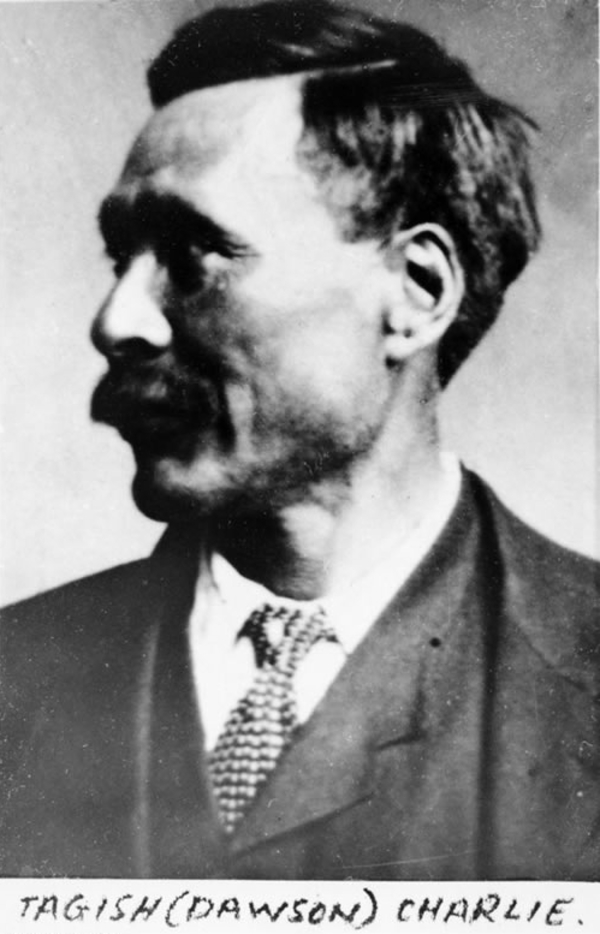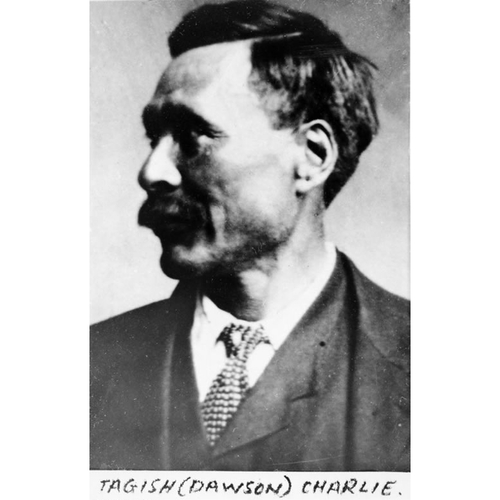
Source: Courtesy of Wikimedia Commons
KÁA GOOX (Charlie, Dawson Charlie), Tagish; b. near Caribou Crossing (Carcross, Y.T.); d. 26 Dec. 1908 in the vicinity of Carcross.
Káa Goox was born to a Tagish mother, Kooyáy, and a Tlingit father, Tlawch’, probably during the 1860s when inter-tribal trade between the coastal Tlingit and the interior Athapaskan groups was at its height. A significant influence on his life was his maternal uncle, Skookum Jim [Keish*]. In Tagish society individuals trace their descent through the maternal line, and matrilineally linked family members claim membership in the same clan. At the time that Káa Goox was a child, a boy’s maternal uncle was probably the person most important to him because of their clan ties. Similarly, every Tagish man was responsible for the welfare of his sisters because they were members of his clan rather than of their father’s or husband’s. By the mid 1890s, two of Jim’s sisters had married white prospectors looking for gold on the Yukon River, and each one had left her family to accompany her husband downriver to an area where signs appeared promising. Local people insist that Charlie, as Káa Goox became known, and his uncle were not searching for gold when they travelled to the Klondike River in 1896, but rather that they were concerned about the two women and were behaving in a socially responsible manner by going to check on them. The fact that in August 1896, on Rabbit (Bonanza) Creek, they discovered gold in the company of their brother-in-law George Washington Carmack and that the find led to the most spectacular gold-rush in North America is almost incidental to the main narrative told by their Tagish descendants. This perspective contrasts sharply with the story in written gold-rush literature picturing Jim (and presumably his nephew) as someone who, in the words of Pierre Berton, “longed to be a white man – in other words, a prospector,” and as a person who “displayed the white man’s kind of ambition.”
In any event the discovery could not help but have an impact on the lives of Charlie and his uncle. Charlie became a wealthy man, made trips to Seattle, Wash., and San Francisco, and later came back and purchased the Caribou Hotel in Carcross. He married a woman named Sadusge and they had two children, a boy and a girl, but the lifestyle that accompanied his new fortune ultimately caused them problems, and the couple separated. Charlie died in 1908 when he fell off a railway bridge and drowned.
Because Charlie was involved in the find at the site later called Dawson City, he earned the nickname Dawson Charlie when he came home. In written accounts, however, he is invariably referred to as Tagish Charlie, presumably because whites knew he came from the vicinity of Tagish Lake. The misnomer causes confusion because Yéil S’aagí, who guided early survey parties but was never involved in the discovery of gold, was known around Carcross as Tagish Charlie. To emphasize the distinction between the two, elders from the community now point to their separate graves in the local cemetery, Tagish Charlie’s with his clan crest, a beaver, on his stone, and Dawson Charlie’s whose gravestone bears his wolf crest. The point of these crests, clear to any Tagish or Tlingit person, has often been lost on outsiders and this oversight underscores the complexity of translating historical events across cultural boundaries.
[Most of this article is based on Tagish oral tradition, and especially on the contributions of Mrs Angela Sidney*, a niece of Káa Goox according to the Tagish system of kinship reckoning. The genealogical background is drawn from Haa shagóon (our family history) (Whitehorse, 1983), which she prepared in collaboration with Julie Cruikshank. Additional discussion of the Klondike discovery appears in the author’s thesis, “Life lived like a story: cultural constructions of life history by Tagish and Tutchone women” (phd thesis, Univ. of B.C., Vancouver, 1987), published as Life lived like a story: life stories of three Yukon natives (Lincoln, Nebr., 1990). j.c.]
Pierre Berton, Klondike: the life and death of the last great gold rush (Toronto, 1958). Julie Cruikshank, “Images of society in Klondike goldrush narratives: Skookum Jim and the discovery of gold,” Ethnohistory (Durham, N.C.), 39 (1992): 20–41. William Ogilvie, Early days on the Yukon & the story of its gold finds (Ottawa, 1913). A. A. Wright, Prelude to bonanza: the discovery and exploration of the Yukon (Sidney, B.C., 1976).
Cite This Article
Julie Cruikshank, “KÁA GOOX (Charlie, Dawson Charlie),” in Dictionary of Canadian Biography, vol. 13, University of Toronto/Université Laval, 2003–, accessed January 18, 2026, https://www.biographi.ca/en/bio/kaa_goox_13E.html.
The citation above shows the format for footnotes and endnotes according to the Chicago manual of style (16th edition). Information to be used in other citation formats:
| Permalink: | https://www.biographi.ca/en/bio/kaa_goox_13E.html |
| Author of Article: | Julie Cruikshank |
| Title of Article: | KÁA GOOX (Charlie, Dawson Charlie) |
| Publication Name: | Dictionary of Canadian Biography, vol. 13 |
| Publisher: | University of Toronto/Université Laval |
| Year of publication: | 1994 |
| Year of revision: | 1994 |
| Access Date: | January 18, 2026 |



